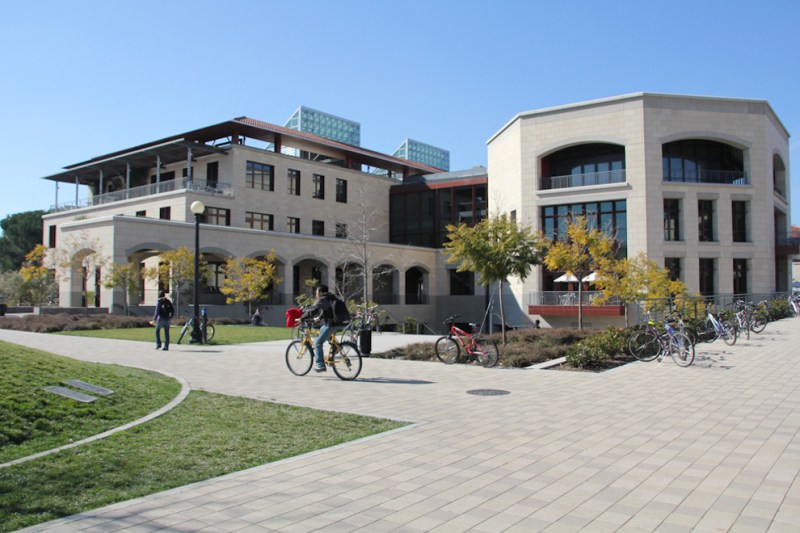In the fall of 2017, our sophomore year, we met in Lathrop Library during office hours for CS 110. We made eye contact, finding companionship in the matching baffled expressions we wore as the TA discussed unix file systems. As the quarter progressed, we shared our love for caffeine, exchanged popcorn recipes and compared our CS+Social Good rejection emails, finding joy and reprieve from our coursework in this new friendship. Before long, we began to confide in one another, and as the pressure cooker that is Stanford’s fall recruiting atmosphere began to bubble, we shared our growing anxieties about finding a tech internship.
As computer science majors, it felt like fall quarter was our only chance at finding an internship — or at least a “good” internship: at one of the companies whose logos stickered the backs of Macbook Pros and Hydro Flask water bottles, whose lines were the longest at every career fair, where our TAs and professors had developed technical skills.
We attended these career fairs and information sessions together, collecting our fair share of t-shirts and gadgets. After stressful nights of interview prep and a number of emotional breakdowns and anxiety attacks, we reached the pinnacle of CS success in November of sophomore year — acquiring summer internships!
Working in industry had always been the glimmering light at the end of the tunnel, the time we could use our education to work on something important. But our roles were not all they promised to be. The scores of students that idealized the experience, recruiters who assured us of our potential and our own belief in lofty missions contrasted with harsh realities. For something we had worked hard to achieve, we felt unfulfilled and discouraged by our lack of impact. We felt embarrassed by the amount of money and resources spent on internal tools and perks. While we began Stanford excited to contribute to a more equitable society with the help of technology and data, we were surrounded by tech for tech’s sake. Each emerging startup and product seemed to be creating a solution for a problem that didn’t even exist.
It wasn’t until senior year that we discovered the public interest tech (PIT) sector: an interdisciplinary branch of engineering and policy work focused on public service. Previously, we had seen public service and our engineering coursework as vastly separate worlds, but this discovery illuminated for us the existence of groups using technology to serve others, especially those who have been pushed out of much of tech’s rapid success.
JustFix, for example, builds technology for housing justice, a mission that sharply contrasts the tech industry’s outsized effects on gentrification, and Raheem is an accountability tool that allows communities of color to report police misconduct. Civic tech companies like Code for America bring innovation to the government sector as well through services that advance automatic record clearance and CalFresh enrollment. Organizations like these — both for-profit and nonprofit — are dedicated to building products that have measurable social impact, founded out of the same entrepreneurial spirit that Stanford Engineering culture praises: a hybrid of tech innovation and social good.
The growing pressure on established tech companies, like the ones we interned at after sophomore year, to use their money and resources to give back has helped elevate public interest technology as well. For example, Salesforce and Airbnb have recently hired Chief Ethics Officers, Facebook launched its annual Social Good Forum in 2016 and Microsoft created a Tech for Social Impact team in 2017.
In industry, entry-level positions at public interest tech orgs or on public interest tech teams are difficult to find, but they certainly exist. These positions span a broad range of areas such as government offices, large corporations, tech nonprofits, startups, think tanks and community organizations. We both now work with the Haas Center for Public Service to increase awareness of such roles on campus through events, programming and post-graduate fellowships.
We encourage you to get involved today! As sophomores, we thought there were only limited ways to get involved in this sector on campus, but now we graduate with a strong sense of hope. This growing ecosystem will continue to be championed by students and faculty such as Constanza Hasselmann and Nik Marda, co-presidents of the Public Interest Tech Design Lab; Sharad Goel, founder of the Stanford Computational Policy Lab; Students for the Liberation of All People, who have facilitated #NoTechForICE panels and protests; Sasankh Munukutla, president of CS+Social Good; Onyi Ozoma, president of The Society of Black Scientists and Engineers; Ananya Karthik, Tech and Racial Justice Student Fellow for CCSRE and many more. Whether you’re active in the PIT space or this is the first you’ve heard of it, share your ideas about PIT initiatives on campus via this feedback form.
As we begin our professional lives, we will continue to be advocates for PIT efforts on campus and beyond, humbled that Stanford has allowed us to drive the change that our sophomore selves would be proud to see.
Contact Priya Chatwani at priyac5 ‘at’ stanford.edu and Dina Safreno at dinas ‘at’ stanford.edu.
The Daily is committed to publishing a diversity of op-eds and letters to the editor. We’d love to hear your thoughts. Email letters to the editor to eic ‘at’ stanforddaily.com and op-ed submissions to opinions ‘at’ stanforddaily.com.
